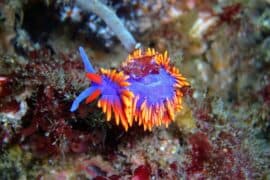Nurseryweb spider
(Dolomedes minor)

Description
Dolomedes minor is a spider in the family Pisauridae that is endemic to New Zealand, where it is known as the nursery web spider. Dolomedes minor is pale brown with some being grayish, like the rocks around which they live, helping to camouflage them against predators. (Arnqvist, 1992) The spider has large pedipalps, which are usually used for sensory purposes. The palps in the male Dolomedes minor are modified for putting sperm into the female's epigyne, which is located on the underside of the female's abdomen. The female Dolomedes minor can easily be identified based on this location of the epigyne. They possess large chelicerae, which are located just below the eyes. (Andrews, 1986) The spider has a body length of about 18 mm. The females are almost twice the size of the males. They move very fast and possess a long leg-span: over sixty millimeters for a fully grown female. Dolomedes minor is found in a variety of habitats throughout New Zealand. They survive in a variety of terrains, from sea level up to subalpine areas, including shrubland containing Gorse (Ulex europaeus) and Manuka (Leptospermum scoparium), swamps and grasslands. When hunting, they can be seen waiting around the water's edge and active amongst the stones, although they are nocturnal hunters. The spider is noticeable in these areas due to the large white nests thickly webbed to the ends of plants throughout these regions. Females will usually remain with their young in these habitats once their nursery webs have been constructed. As a nocturnal species, Dolomedes minor hunts and scavenges for food at night. The prey spectrum of the spider consists of a variety of small organisms including locusts, other spiders, Dobson fly larvae, earthworms, bees and other small insects (Williams, 1978). Although Dolomedes is an effective hunter, previously deceased organisms will also be accepted as food. The spider does not use its web at any point during predation, but rather captures prey through methods of hunting. The spider tends to take a passive approach to hunting however, waiting for prey to make contact with it before attacking. Despite having four prominent posterior eyes, Dolomedes minor relies entirely on touch and chemical perception rather than sight in the detection of prey.
Taxonomic tree:







